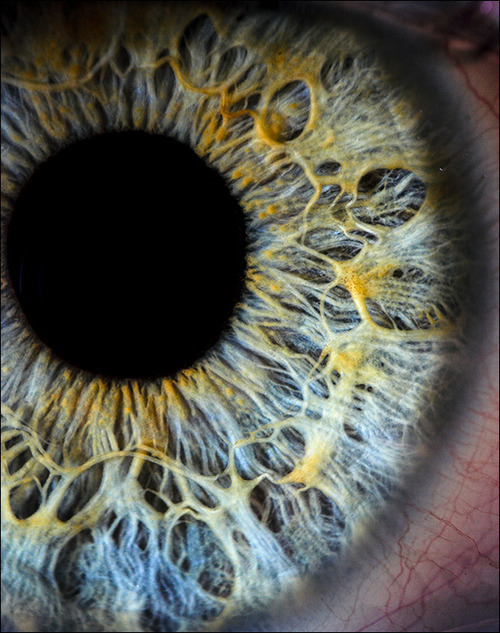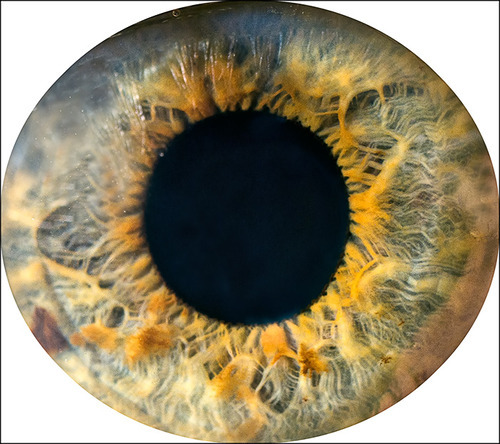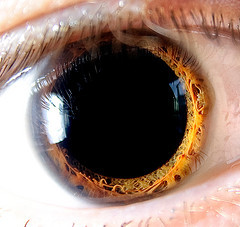Saturn: Oh You Wanted A Twist?

Saturn: Oh you wanted a twist?
More Posts from Science-is-magical and Others
It always creeps me out...
…that no matter

how close

you get

the pupil

seems to

devour light

like a black hole

it reflects no light

The folks over at NASA just featured this nifty infographic on APOD about detecting objects in the sky:
How to Identify that Light in the Sky
What is that light in the sky?
Perhaps one of humanity’s more common questions, an answer may result from a few quick observations.
Image: HK (The League of Lost Causes)
For example — is it moving or blinking? If so, and if you live near a city, the answer is typically an airplane, since planes are so numerous and so few stars and satellites are bright enough to be seen over the din of artificial city lights.
If not, and if you live far from a city, that bright light is likely a planet such as Venus or Mars — the former of which is constrained to appear near the horizon just before dawn or after dusk.
Sometimes the low apparent motion of a distant airplane near the horizon makes it hard to tell from a bright planet, but even this can usually be discerned by the plane’s motion over a few minutes. Still unsure?
The above chart gives a sometimes-humorous but mostly-accurate assessment. Dedicated sky enthusiasts will likely note — and are encouraged to provide — polite corrections.

A Powerful Solar Flare : It was one of the most powerful solar flares in recorded history. Occurring in 2003 and seen across the electromagnetic spectrum, the Sun briefly became over 100 times brighter in X-rays than normal. The day after this tremendous X 17 solar flare – and subsequent Coronal Mass Ejection (CME) – energetic particles emitted from the explosions struck the Earth, creating auroras and affecting satellites. The spacecraft that took these frames – SOHO – was put in a turtle-like safe mode to avoid further damage from this and subsequent solar particle storms. The featured time-lapse movie condenses into 10 seconds events that occurred over 4 hours. The CME, visible around the central sun-shade, appears about three-quarters of the way through the video, while frames toward the very end are progressively noisier as protons from the explosions strike SOHO’s LASCO detector. One this day in 1859, the effects of an even more powerful solar storm caused telegraphs on Earth to spark in what is known as the Carrington Event. Powerful solar storms such as these may create beautiful aurora-filled skies, but they also pose a real danger as they can damage satellites and even power grids across the Earth. via NASA

Bruh this is some sci-fi shit. Fucking time crystals

Cullen and Romulus are the world’s first set of identical twin puppies. While it’s possible that canines could have produced twins in the past, these Irish wolfhounds are the first to be medically documented and confirmed with DNA testing. Source Source 2


(Image caption: The above image compares the neural activation patterns between images from the participants’ brains when reading “O eleitor foi ao protesto” (observed) and the computational model’s prediction for “The voter went to the protest” (predicted))
Brain “Reads” Sentences the Same in English and Portuguese
An international research team led by Carnegie Mellon University has found that when the brain “reads” or decodes a sentence in English or Portuguese, its neural activation patterns are the same.
Published in NeuroImage, the study is the first to show that different languages have similar neural signatures for describing events and scenes. By using a machine-learning algorithm, the research team was able to understand the relationship between sentence meaning and brain activation patterns in English and then recognize sentence meaning based on activation patterns in Portuguese. The findings can be used to improve machine translation, brain decoding across languages and, potentially, second language instruction.
“This tells us that, for the most part, the language we happen to learn to speak does not change the organization of the brain,” said Marcel Just, the D.O. Hebb University Professor of Psychology and pioneer in using brain imaging and machine-learning techniques to identify how the brain deciphers thoughts and concepts.
“Semantic information is represented in the same place in the brain and the same pattern of intensities for everyone. Knowing this means that brain to brain or brain to computer interfaces can probably be the same for speakers of all languages,” Just said.
For the study, 15 native Portuguese speakers — eight were bilingual in Portuguese and English — read 60 sentences in Portuguese while in a functional magnetic resonance imaging (fMRI) scanner. A CMU-developed computational model was able to predict which sentences the participants were reading in Portuguese, based only on activation patterns.
The computational model uses a set of 42 concept-level semantic features and six markers of the concepts’ roles in the sentence, such as agent or action, to identify brain activation patterns in English.
With 67 percent accuracy, the model predicted which sentences were read in Portuguese. The resulting brain images showed that the activation patterns for the 60 sentences were in the same brain locations and at similar intensity levels for both English and Portuguese sentences.
Additionally, the results revealed the activation patterns could be grouped into four semantic categories, depending on the sentence’s focus: people, places, actions and feelings. The groupings were very similar across languages, reinforcing the organization of information in the brain is the same regardless of the language in which it is expressed.
“The cross-language prediction model captured the conceptual gist of the described event or state in the sentences, rather than depending on particular language idiosyncrasies. It demonstrated a meta-language prediction capability from neural signals across people, languages and bilingual status,” said Ying Yang, a postdoctoral associate in psychology at CMU and first author of the study.

Glutamate, an essential food for the brain
Glutamate is an amino acid with very different functions: in the pancreas, it modulates the activity of the pancreatic ß-cells responsible for insulin production, whereas in the brain it is the main excitatory neurotransmitter. In recent years, it has been suspected to play an additional role in the functioning of the brain. By discovering how the brain uses glutamate to produce energy, researchers at the University of Geneva (UNIGE) confirm this hypothesis and highlight unexpected links with the rest of the body. To read in Cell Reports.
Unlike other organs, the brain cannot draw its energy from lipids, an energy resource widely present in the body. The blood-brain barrier, which protects it from the pathogens and toxins circulating in the blood, indeed limits the passage of these lipids. Moreover, while most of the organs in the human body have the ability to store glucose by increasing their mass, the brain, prisoner of the cranial bones, cannot count on these variations in volume. Unable to store its food, it depends on sugar supplied in real-time by the rest of the body. This distribution of energy is controlled by the liver.
Pierre Maechler, professor at the Faculty of Medicine at UNIGE, and his team therefore decided to verify if glutamate was indeed an energy source for the brain. To do so, the researchers analyzed the role of the glutamate dehydrogenase enzyme in the brain. In mutant form, this enzyme, encoded by the Glud1 gene, is responsible for a congenital hyperinsulinism syndrome, a severe disease affecting at the same time the endocrine pancreas, the liver and the brain. Individuals affected by this syndrome suffer from intellectual disability and have a high risk of epilepsy. “We have suppressed the Glud1 gene in the brain of mice. In the absence of glutamate dehydrogenase, we observed that the brain was no longer able to convert glutamate into energy, even though the amino acid was present in the brain,” explains Melis Karaca, first author of this study.
Priority to the brain
Devoid of the energy supplied by cerebral glutamate, the brain sends signals to the liver to requisition a compensatory proportion of glucose, at the expense of the rest of the body. This is why the transgenic mice also showed a growth deficit and muscle atrophy. “This clearly shows how the brain works in a just-in-time manner and that each percent of energy resources is essential for its proper functioning,” highlights Professor Pierre Maechler. “If a part of this energy disappears, the brain serves itself first and the rest of the body suffers. The liver must then make more glucose by drawing upon muscle protein, resulting in loss of muscle mass. Knowing that the brain uses glutamate as an energy resource allows us to reflect on other ways to overcome a potential shortfall. ”
Scientists also suspect a correlation between the Glud1 gene and some neurodevelopmental disorders, particularly epilepsy and schizophrenia. They are currently pursuing their research by introducing in mice the same Glud1 mutation detected in epileptic patients. At the same time, another group is working with schizophrenic patients to assess the way their brain uses glutamate.
-
 riverplatenseee reblogged this · 1 year ago
riverplatenseee reblogged this · 1 year ago -
 riverplatenseee liked this · 1 year ago
riverplatenseee liked this · 1 year ago -
 konoharu liked this · 1 year ago
konoharu liked this · 1 year ago -
 athousandlayersoftulle liked this · 1 year ago
athousandlayersoftulle liked this · 1 year ago -
 abstraxx liked this · 1 year ago
abstraxx liked this · 1 year ago -
 sepiasims liked this · 1 year ago
sepiasims liked this · 1 year ago -
 mangojunkrat liked this · 2 years ago
mangojunkrat liked this · 2 years ago -
 floatinglonewanderer liked this · 2 years ago
floatinglonewanderer liked this · 2 years ago -
 black-sharpies liked this · 2 years ago
black-sharpies liked this · 2 years ago -
 divergentlesbianmarvelgeek liked this · 4 years ago
divergentlesbianmarvelgeek liked this · 4 years ago -
 arialis reblogged this · 4 years ago
arialis reblogged this · 4 years ago -
 someonebored0100 liked this · 4 years ago
someonebored0100 liked this · 4 years ago -
 greentea-honey-lemon liked this · 4 years ago
greentea-honey-lemon liked this · 4 years ago -
 seriousmatterofshitsandgiggles liked this · 4 years ago
seriousmatterofshitsandgiggles liked this · 4 years ago -
 leiler-durr liked this · 5 years ago
leiler-durr liked this · 5 years ago -
 aesthetic-and-study liked this · 5 years ago
aesthetic-and-study liked this · 5 years ago -
 nexus-heroes reblogged this · 5 years ago
nexus-heroes reblogged this · 5 years ago -
 nexus-heroes liked this · 5 years ago
nexus-heroes liked this · 5 years ago -
 hanabi-09 reblogged this · 5 years ago
hanabi-09 reblogged this · 5 years ago -
 crocophant liked this · 5 years ago
crocophant liked this · 5 years ago -
 eganccc liked this · 5 years ago
eganccc liked this · 5 years ago -
 microfiber-blanket liked this · 6 years ago
microfiber-blanket liked this · 6 years ago -
 itsstarling reblogged this · 6 years ago
itsstarling reblogged this · 6 years ago -
 itsstarling liked this · 6 years ago
itsstarling liked this · 6 years ago -
 trans-titan liked this · 6 years ago
trans-titan liked this · 6 years ago -
 artyoma liked this · 6 years ago
artyoma liked this · 6 years ago -
 bitchydragonninja liked this · 6 years ago
bitchydragonninja liked this · 6 years ago -
 sunshine4591 liked this · 6 years ago
sunshine4591 liked this · 6 years ago -
 otisrook liked this · 6 years ago
otisrook liked this · 6 years ago -
 kissybunny reblogged this · 6 years ago
kissybunny reblogged this · 6 years ago -
 wanderinwonderlust reblogged this · 6 years ago
wanderinwonderlust reblogged this · 6 years ago -
 paigecowen liked this · 6 years ago
paigecowen liked this · 6 years ago -
 n0t-my-real-name liked this · 6 years ago
n0t-my-real-name liked this · 6 years ago -
 peachhealing reblogged this · 6 years ago
peachhealing reblogged this · 6 years ago -
 saulonunes34 liked this · 6 years ago
saulonunes34 liked this · 6 years ago -
 nocanadans liked this · 6 years ago
nocanadans liked this · 6 years ago -
 spicixkitty-amanda liked this · 6 years ago
spicixkitty-amanda liked this · 6 years ago






